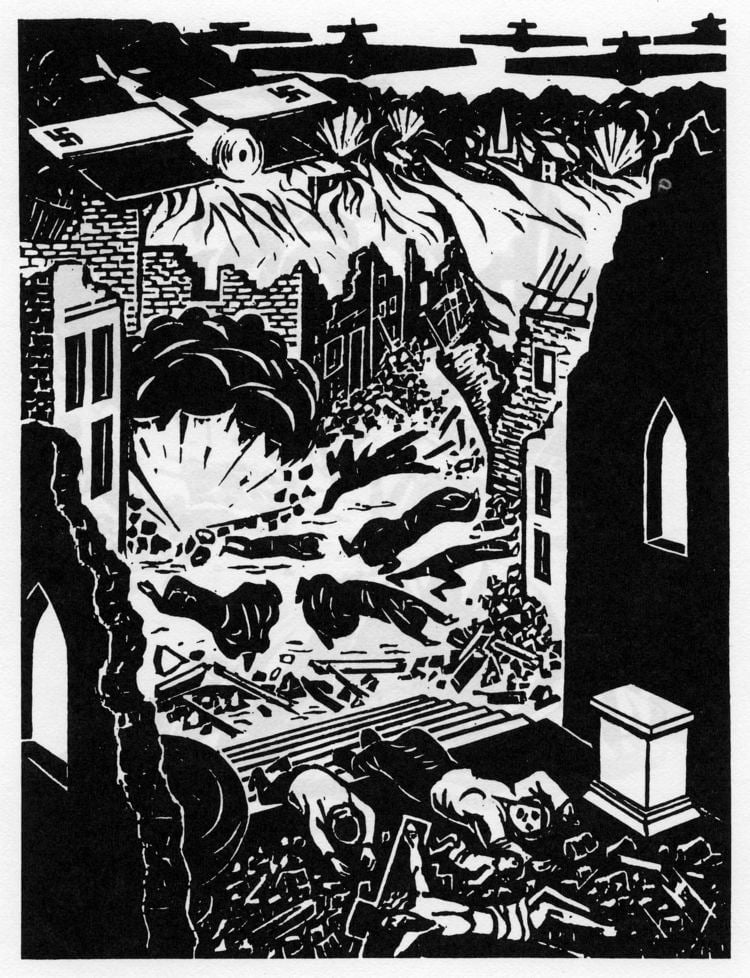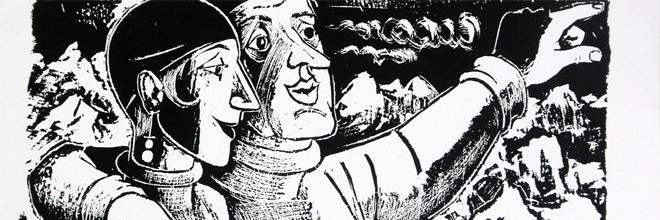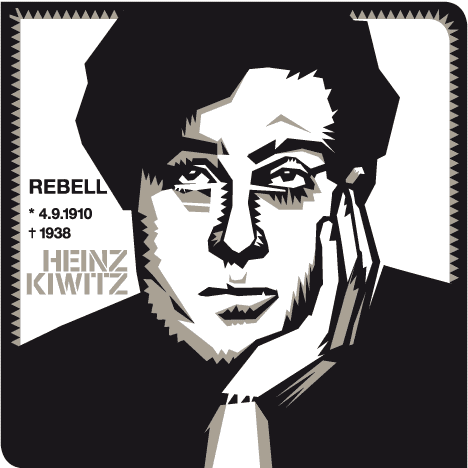Nationality German Name Heinz Kiwitz Website www.heinzkiwitz.de | Movement German Expressionism Known for woodcut illustration Died 1938, Spain | |
 | ||
Education | ||
Heinz kiwitz aus der sammlung hg krusch im kunstverein duisburg 2 gesprache
Heinz Kiwitz (September 4, 1910 – 1938) was a German artist. His woodcuts were in the German Expressionist style. An anti-fascist, he was arrested following the Nazis' seizure of power. He survived imprisonment in Kemna and Börgermoor concentration camps and was released in 1934. He went into exile in 1937, first living in Denmark, then in France, where he again began to fight Nazism. In 1938, he went to Spain to fight in the Spanish Civil War, where he apparently perished.
Contents
- Heinz kiwitz aus der sammlung hg krusch im kunstverein duisburg 2 gesprache
- Kunstverein duisburg einordnung des kunstlers heinz kiwitz von pd dr ludger j heid ude
- Early years
- Work and anti fascist resistance
- Open letter to Hitler
- Recognition
- Works selected
- References

Kunstverein duisburg einordnung des kunstlers heinz kiwitz von pd dr ludger j heid ude
Early years

Kiwitz was born the son of a book printer and was exposed to the graphic arts from an early age. He had an older sister, Änne, and a younger sister, Gertrude, called Trudel. From early on, he loved to draw, but was not good in math. At the age of 10, he drew his older sister's art assignments and she received top grades. When he was 17 and stood 1.92 meters (6.3 ft), he joined a boxing club and trained at home, causing the furniture to shake when he jumped rope inside.

In 1927, he began studying art with Karl Rössing at the Folkwang University of the Arts in Essen. His long-time friend, Günther Strupp also attended the school and was a student of Rössing's. He was a member of the Association of Revolutionary Visual Artists during this period.
Work and anti-fascist resistance

In art school, he preferred to create wood engravings, but after finishing, Kiwitz began working more with woodcuts, which entailed a process more suited to his temperament. He and Strupp went to Cologne for a few months and later, he went to Berlin to pursue work and further study. In April 1932, his woodcut illustrations for a satirical poem by Erich Weinert were published along with the poem in Magazin für Alle. He also made a woodcut decrying the Nazi book burnings and one that features caricatures of Hitler, Goebbels and Göring (see illustration). In early 1933, after the Nazis seized power, Kiwitz' studio was ransacked by the Sturmabteilung (SA) and he left Berlin, returning to his parents' home. He also visited his girlfriend, who as a Communist and political enemy of the Nazis, had been arrested and thrown in prison.
Shortly after, in summer 1933, he also was arrested and thrown in Kemna concentration camp for "antifascist activity" and having produced "work critical of society". From Kemna, he was later transferred to Börgermoor concentration camp. After his release in June 1934, he sought to protect himself from further arrest by destroying the majority of his political artwork and confining his illustrations to literary themes. He described himself as a "Nazi-coerced-towards-harmless-themes-political-journalist." He returned to Berlin in 1935, where he worked for the publisher Ernst Rowohlt. He designed covers for books by William Faulkner and created illustrations for a novel by Hans Fallada; he also made woodcuts illustrating Don Quixote, and Eduard Mörike's "Die Historie von der schönen Lau", among others.
As a socialist, Kiwitz saw little future and only danger for himself in Germany. In 1937, with help from Rowohlt, he managed to flee to Copenhagen, Denmark, where he met Bertolt Brecht. His residence permit, just three months, was not renewed, forcing him to leave. He then went to Paris, where he again began to fight fascism. An organization of exiled German artists, the Union des Artistes Allemands Libres, was founded in autumn 1937 and Kiwitz became an early member. The group organized an exhibit called "Five Years of Hitler Dictatorship", (Fünf Jahre Hitler-Diktatur) held at a local union hall. He worked on the exhibition and contributed to the exhibition brochure, Cinq Ans de Dictateure Hitlerienne, cutting out a piece of linoleum flooring from under his bed and making linocuts depicting torture, courtroom trials and forced labor in the Third Reich. Also while in Paris, he made a woodcut about the Bombing of Guernica and other alleged war crimes.
Letters to his parents during this time do not mention his political activities, but a request for a sum of money (10 Reichmarks) indicates his financial status was precarious. Kiwitz worked for the emigrant press while in Paris and on August 27, 1937, published his Absage eines deutschen Künstlers an Hitler ("Renunciation of Hitler by a German Artist") in a Paris newspaper. In 1938, he went to Spain to fight against Francisco Franco in the International Brigades. He is known to have participated in the Battle of the Ebro, but then all trace of him vanishes. He is presumed to have been killed there.
Open letter to Hitler
The text of Kiwitz' 1937 open letter of renunciation to Hitler printed below was printed in a German-language exile newspaper in Paris.
Recognition
Kiwitz is grouped with Wilhelm Lehmbruck and August Kraus as one of the most important 20th-century artists from Duisburg. In 1962, the Städtisches Kunstmuseum (City Art Museum) in Duisburg had an exhibit of Kiwitz' work and in 1992, the Lehmbruck Museum in Duisburg had an exhibit called "Heinz Kiwitz Druckgraphik". From April 1983 to April 1984, there was a traveling exhibit of Kiwitz' work. Called "Heinz Kiwitz : Holzschnitte, Linolschnitte und Zeichnungen", the exhibit started in Lüdenscheid, then moved to Telgte, then to the Städtisches Museum in Gelsenkirchen and then finished at the Galerie im Theater in Gütersloh. There is a street in Duisburg named Heinz-Kiwitz-Strasse in his honor in 2005. In 2010, in honor of the 100th anniversary of his birth, the Brennender Dornbusch Foundation organized an exhibit of Kiwitz' work at the Liebfrauenkirche in Duisburg. His younger sister, Trudel Siepmann, attended the opening.
